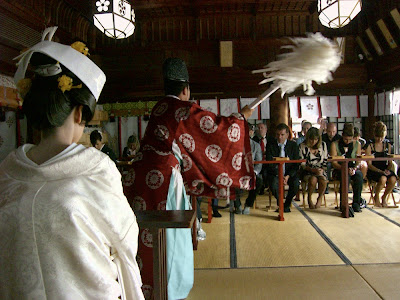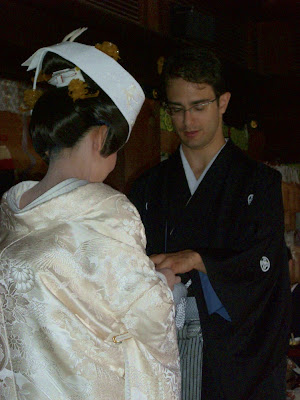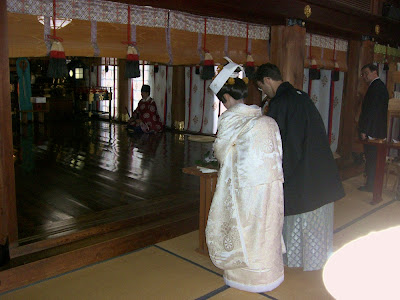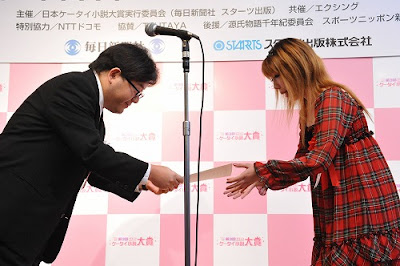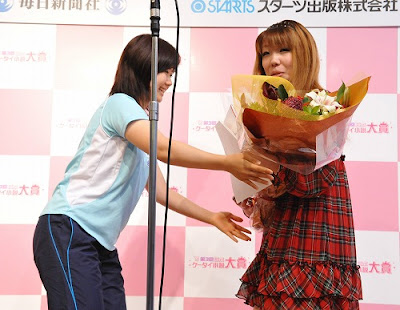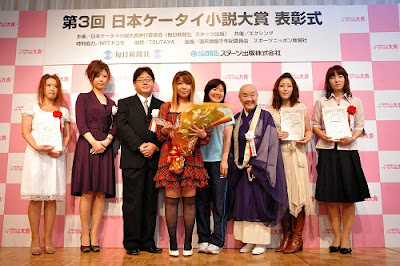Os voy a explicar paso a paso cómo fue nuestra boda japonesa sintoísta, que tuvo lugar en el templo Hofu Tenmangu. No voy a ser muy riguroso pero espero que a alguien le sirva para tener una idea general.
防府天満宮で行われた僕たちの結婚式の流れを軽く説明してみる。あまり詳しくないけど、だいたいどんな感じか知りたい人のお役に立てば、嬉しい。
I’m going to explain lightly the flow of our Japanese Shinto wedding at Yamaguchi Prefecture’s Hofu Tenmangu. I’m not going to be very accurate but I hope this entry will be interesting for some people.
photo: josecrem
Esta es la mayoría de la gente que vino desde España a la boda. En total eran 20.
スペインから来てくれたほとんどの人。全員そろったらなんと20人。
Most of the people who came from Spain for our wedding. There were 20 of them in total.
Antes de la boda, la novia está con su familia.
挙式の直前、新婦はその親族と一緒。
Before the ceremony, the bride is with her family.
photo: josecrem
Y el novio con la suya. Hay una habitación habilitada en plan camerino para cada «equipo».
新郎はまたその親族(と親友)の控え室にいた。
And the groom is with his. There’s a backstage-like room for each «team».
photo: josecrem
Aquí el equipo de la novia sentado en dos filas, en el lado izquierdo de la capilla principal. Si pudiéramos mirar a la derecha de esta foto se vería el altar.
本堂の左側で二列に並んだ「新婦チーム」。この写真の右に本堂があった。
Here’s the bride’s team sitting in two rows, on the left side of the main shrine. If you could have a look at the right of this picture you would see the shrine.
Y mi equipo sentado frente a ellos, en el lado derecho de la capilla. Era la primera vez que muchos de los españoles entraban en un jinja (templo sintoísta) pero todo fue muy mágico, emotivo, y todos los invitados siguieron el protocolo como un solo hombre.
そして向かい合わせで座った僕のチーム。神社に入るのが初めてというスペイン人が多かったけど、自然に流れにのれたみたい。神秘的、感動的な時間が続いた。
And this is my team sitting opposite to the other, on the right side of the shrine. It was te first time many of these people went into a jinja (Shinto shrine) but everything felt like magic and it was very moving. People would follow the ceremony perfectly.
El sacerdote nos bendice a todos antes de empezar la ceremonia. Agachamos ligeramente la cabeza.
みんなにお祓いをしてくれる神主さん。頭を軽く下げる。
The priest blesses us all before starting. We bow slightly.
photo: josecrem
Sansankudo: las miko (monaguillas) me ponen o-miki (sake sagrado) en tres platos de forma consecutiva. Cada uno de los platos me lo acerco a la boca dos veces y solo bebo a la tercera. Total: nueve intentos y tres tragos.
三三九度。巫女さんが盃三枚にお神酒を注いでくれた。一枚ごとに、三回口につけてその三回目だけ飲む。合計は、九回口につけてその中から三回だけ飲む。
Sansankudo: the miko (shrine maidens) serve me omiki (sacred sake) on three dish-shaped cups. Every cup, I take it near my mouth for 3 times but only drink the last one. Totals: 9 tries, 3 successes.
Ai solo se mojó los labios porque el alcohol le sienta mal. Creo que lo que le sobró a ella me lo pusieron todo a mí.
愛はお酒に弱いから、口をつけることだけにした。残されたお神酒は全部僕に回ってきた気がする。
Alcohol is no good for Ai’s body, so she didn’t drink any of the omiki she was served. I have a feeling they gave me all of her leftovers.
Leemos al unísono los votos de matrimonio. Es un japonés difícil, pero como para muchos japoneses también es complicado siempre hay anotaciones con la pronunciación de los kanji.
誓いの言葉を二人で一緒に読み上げる。複雑な漢字ばかりだけど、幸い日本人にとっても難しいのか、ふりがながついていた。
We read together our wedding vows. They are filled with rare kanji but it looks like they are hard for many Japanese people so there were hints for pronunciation everywhere.
Intercambio de anillos. A mí se me cayó el suyo al suelo pero creo que no se dio cuenta nadie (una de las dos partes de esta frase es mentira, hagan sus apuestas).
指輪交換。僕は落としたけど誰も気付かなかったかな?(そんな訳ないけど)
Exchanging rings. I dropped Ai’s ring but I think nobody noticed. Game: find a lie in last sentence.
Tamagushi hōten: ofrecemos unas ramas al altar. Tenemos que girarlas doscientos setenta grados en el sentido de las agujas del reloj para que queden mirando en la dirección correcta.
玉串奉奠。枝が本堂に向くように、時計回りに二百七十度回した。
Tamagushi hōten: offering some branches to the Shrine. We had to turn them two hundred and seventy degrees clockwise so that they were oriented to the Shrine.
El sacerdote da su bendición a nuestro matrimonio.
神主さんからお祝いの言葉をもらった。
The priest then gave us his blessing for our marriage.
photo: josecrem
Un regalo de parte del templo. ¡No me lo esperaba! La ceremonia había ido como la seda y todo el mundo estaba emocionado y súper contento.
防府天満宮からのプレゼント。期待していなくて嬉しかった!式がスムーズに流れて、みんな感動していたし、喜んでいた。
A present from the Shrine. I didn’t expect it! The ceremony had been smooth and moving, and people were very happy.
photo: josecrem
Y salimos del templo y nos fuimos a… ¡continuará!
そして神社を後にすると・・・つづく!
So we came out of the Shrine and… To be continued!

